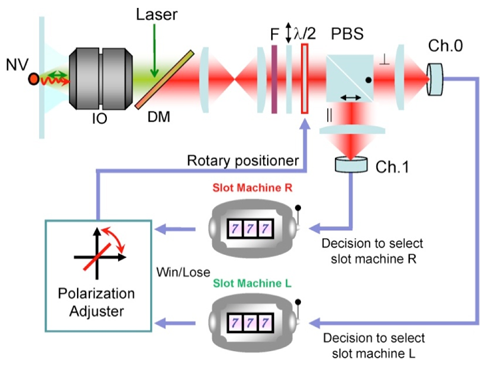The need to make accurate decisions in uncertain, dynamically changing environments appears in all aspects of life. Consider, e.g., an information network infrastructure. Ever-increasing demands in mobile communications outstrip the available radio frequencies; consequently, dynamic and adequate frequency assignment is critical. This scenario constitutes a decision-making problem in an uncertain environment. As another example, consider maximizing the revenue for an e-commerce website on the Internet; this requires presenting adequate content and advertisement in a limited screen space of typical displays and is also a corollary of decision-making problems.
Several computing algorithms such as ε-greedy, softmax, upper confidence bounds, and tug-of-war (TOW) [1] have been proposed in the literature to solve these decision-making problems. All these algorithms have been designed essentially using probabilistic mechanisms to resolve the “exploration-exploitation dilemma” tradeoff in decision making. The present study aims to physically implement decision making using the intrinsic quantum attributes of single photons.
The TOW algorithm was inspired by the spatiotemporal dynamics of the slime mold Physarum. More specifically, the idea is originally based on observing living organisms in nature and their interactions with various environments. This fact implies that it is possible to engineer artificially constructed decision-making machines, which would contribute significantly to resolving decision-making problems in practical information and communications technology (ICT). Actually, Kim et al. proposed a theory of a TOW-based decision maker that uses nanoscale optical excitation transfer among quantum dots mediated by near-field interactions in 2013 [2]. They followed this study by an experimental verification based on colloidal quantum dots of different sizes in 2014 [3]; this paved the way to the implementation of a solid-state, ultra small decision maker. Moreover, the TOW-based physical method outperforms other algorithms [2].
However, many important unresolved problems remain before we can claim completely autonomous, physical decision-making machines. One of the most critical concerns is that the probabilistic mechanism, which is an indispensable attribute in solving decision-making problems, has not yet been realized experimentally. For instance, in the experimental demonstration reported in Naruse et al. [2], the probabilistic decision-making step was implemented by an electrical host controller and the probability was determined by observing optical energy transfer in ensembles of quantum dots.
In this study, we report decision making based on single photons. One of the most significant attributes of single photons is literally its particle and probabilistic nature. For example, consider a single photon that impinges on a beam splitter. The probability of observing the single photon in one of the two output channels is 50%. However, in detecting individual events, when a single photon is detected in one channel, the other channel does not detect it. We see here a TOW-type mechanism in the sense that an input photon is pulled by one channel and by the other. Observing a single photon can be directly associated with decision making. In other words, without requiring emulation by electrical computing, the decisive step is directly implemented by the intrinsic attributes of a single photon and is fundamentally unachievable using classical light.



































